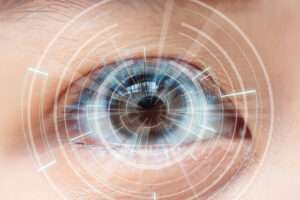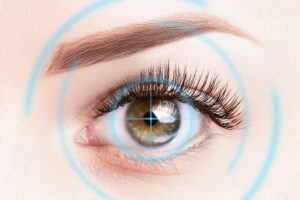
Nystagmus is a vision problem in which the eyes make uncoordinated and uncontrolled movements. In addition to compromising vision and depth perception, it also causes problems with balance and coordination.
Most people with nystagmus seem to be looking quickly from side to side or rapidly looking up and down. They often tilt their heads at an angle to balance their visual field. The condition can be serious enough for some patients to be considered legally blind.
Almost all people with severe nystagmus are born with the condition (congenital) or develop it as infants. So, what’s behind this literally unsettling condition?
Nystagmus Causes Are Often Neurological
There do not seem to be direct nystagmus causes but most cases are thought to be neurological and stem from problems with the inner ear (vestibular) or eye muscles (optokinetic).
In people with vestibular nystagmus, the eyes drift and jerk back into place. Not surprisingly, vertigo (dizziness), and nausea are common problems. It can also be triggered when the water settles inside the ear. Thankfully, this form is temporary for many patients.
People with optokinetic nystagmus often have crossed eyes (medical name: strabismus), in which the eyes are not properly aligned, or cataracts, particularly congenital cataracts. We really don’t understand what causes strabismus, but it has been seen in infants as soon as they open their eyes. In part, this is because their eyesight is still developing. If it continues, there could be a problem with the part of the nervous system that controls eye movement.

Cataracts, which are cloudy areas on the eye lenses, are associated with optokinetic nystagmus. They are fairly common in older people. Congenital cataracts can be inherited or caused by disease in the mother including measles, rubella, chickenpox, flu, sexually transmitted disease, or diabetes.
Some children compensate by using one eye for vision, leading to “lazy” or “wandering” eye in the other. And some people develop this later in life, triggering double vision.
Other neurologic causes for nystagmus come from head injury, stroke, and disease. Lazy eye can be an early sign for stroke. Multiple sclerosis, Meniere’s disease (a condition in which fluids build up in the inner ear and cause imbalances), and albinism (lack of pigmentation) are all thought to be underlying causes as well.
Finally, medications and substance abuse can cause nystagmus in adults and developing fetuses. Also, stress, which is often heightened in people living with difficult neurological conditions, can aggravate nystagmus.
Nystagmus Treatment Includes Surgery and Corrective Lenses
Treating the underlying nystagmus causes is one way to ease or cure the condition. For example, the medication that causes it can be halted. Nystagmus in people with substance abuse problems will ease with successful treatment.
Eyeglasses and contact lenses, including bifocal contact lenses, often improves the condition but won’t cure it. Cataracts can only be cured with surgery. It’s one of the most common surgeries today and is very low risk. In infants, however, the treatment is not so straightforward. Surgery is riskier for them for a number of reasons, and parents should seek out more than one opinion.
In adults and older children, surgery on eye muscles can bring relief from the head tilting position. Botox injections will temporarily reduce the eye movement for adults (this is not recommended in children). Some adult patients benefit from anti-seizure medications and muscle relaxers. Other patients have benefitted biofeedback treatment.
Nystagmus is often a symptom for other conditions. Don’t ignore it in yourself, family members, and especially children and infants. Contact a medical professional for an evaluation.
For more information visit our Diamond Vision website or contact our Atlanta Eye SurgeryCenter in Georgia.
Contact Us
If you have more questions about LASIK procedures, get in touch with us.
Related Blogs

Timing is Everything: When to Consider LASIK After Nursing for Optimal Results
Timing is everything when considering LASIK eye surgery after nursing, and understanding the optimal period for this procedure is vital for both mother and baby.

Cataract Surgery: Restoring Clarity and Confidence
Cataract surgery is a transformative procedure that offers a new lease on clear vision and renewed confidence. As cataracts cloud the eye’s lens, causing blurred

Intralase LASIK Explained: What to Expect Before, During, and After the Procedure
Intralase LASIK is a cutting-edge procedure that offers a safe, effective, and precise way to enhance vision compared to traditional LASIK methods. Understanding what to
